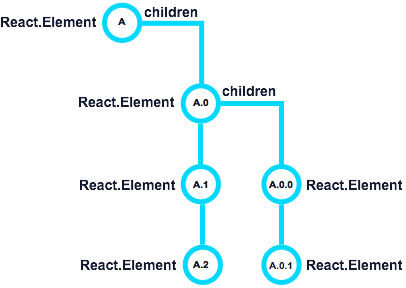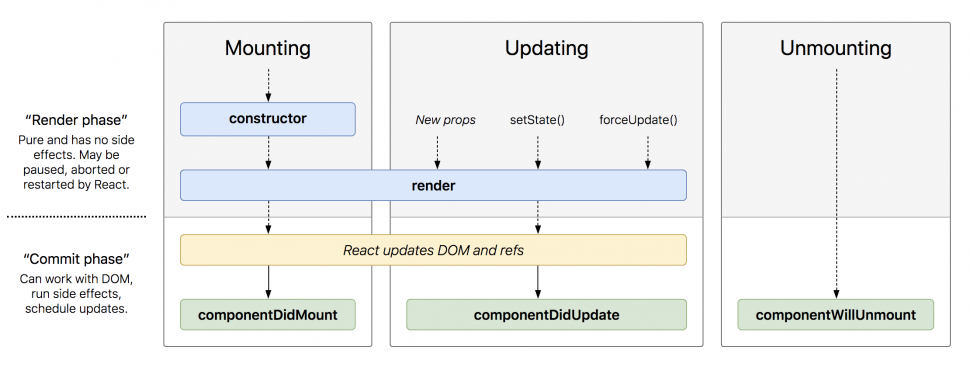This is where AJAX requests and DOM or state updates should occur. Put the async keyword in front of componentDidMount.

Reactjs Lifecycle Of Components Geeksforgeeks
We just have to return a function in the useEffect callback to do this.

React component did mount functional component. Function App ReactuseEffect Runs after the first render lifecycle. In this chapter we will discuss component lifecycle methods. Heres an example with a functional component.
Functional components do not have access to dedicated state variables like. First we will be importing useEffect hook from the react library. Then we can define a sample functional component.
ComponentWillMount is executed before rendering on both the server and the client side. We can do the same thing with the useEffect hook again. Const ComponentExample useEffect Anything in here is fired on component mount.
Import React Component from react. After looking through a bunch of articles and examples on the internet on how to mimic the componentDidMount using useEffect it always seemed like it wasnt just quite how it was supposed to be implemented. If you want to execute something when a React Function Component did mount you can use the useEffect hook.
Use await in the functions body. Make sure to catch eventual errors. ReactJS componentDidMount Method.
Rewriting the to do list as a Function. If you use Fetch API in your code be aware that it has some caveats when it comes to handling errors. The componentDidMount method allows us to execute the React code when the component is already placed in the DOM Document Object Model.
This method is called during the Mounting phase of the React Life-cycle ie after the component is rendered. Import useEffect from react. Functional components are my most favourite thing in React.
Take this class component for example. Import React from react. In this article we are going to see how to execute a function when the component is loaded in the DOM tree.
Const App return Hello World. The component uses componentDidMount lifecycle method to fetch data from a remote source when first rendered and then shows a to do list. The code above uses ReactuseEffect and passes an empty array to emulate the componentDidMount lifecycle.
Nothing new or unusual so far. ComponentDidMount is executed after the first render only on the client side. They are simple purely functional and super easy to reason about.
Lets go through an example of componentDidMount. After the markup is set on the page this technique called by React itself to either fetch the data from An External API or perform some unique operations which need the JSX elements. Functional components lack a significant amount of features as compared to class-based componentsThe gap is made up with the help of a special ReactJS concept called hooksHooks are special functions that allow ReactJS features to be used in functional components.
ReactJS componentDidMount Method. Component source code. This means you can easily use componentDidMount and componentWillUnmount within functional components.
In react native class component the componentdidmount called after render method called. Componentdidmount method used in react native class component coding structure. The following shows an example of a functional component with some typed properties.
As the name suggests after all the elements of the page is rendered correctly this method is called. Second there is the mounting lifecycle for React components when they are rendered for the first time. This method is majorly used during the mounting phase of the React lifecycle to handle all the network requests or to set up all the major subscriptions of the application.
The function we return will run when the component unmounts. Items can be added removed and marked as done all this is achieved by means of updating the component state. Import React useState useEffect from react.
Return Anything in here is fired on component unmount. The componentWillUnmount lifecycle method in a React class component lets us run code when we unmount a component. Export default function App const mounted setMounted useStatefalse useEffect This is similar to componentDidMount Call back-end api here return.
After coming of react native functional component all the mount. Export default class App extends Component componentDidMount. Here are the steps you need to follow for using asyncawait in React.
Import React useEffect from react. The main purpose of componentdidmount is to parse JSON or do some changes on screen after application start.

React Lifecycle Methods React Components Have Their Own By Rohit Kudale Stackavenue Medium

React 16 Lifecycle Methods How And When To Use Them By Scott Domes Bits And Pieces

Where To Put Component Did Mount In My Next Js File Stack Overflow

Mengenal React Hooks Memahami Penggunaan React Hooks Di By Muhammad Naufal Unikom Codelabs Medium

Post Mount With Componentdidmount React Indepth

React Function Component To Class Component Code Example
.png?width=731&name=MicrosoftTeams-image%20(20).png)
Lifecycle Methods And Hooks In React

Understanding React Lifecycle Methods

React Class Component Vs Functional Component By Ven Korolev Itnext

Setinterval React Code Example

Replacing Component Lifecycle Methods With React Hooks

Componentwillmount And Componentdidmount Lifecycle Event React For Beginners 26 Youtube

React Useeffect Hook With Code Examples

Lifecycle Of React Component As We Discussed Already Class By Vignesh S Geek Culture Medium

Everything You Need To Know About Setstate By Annie Wang Hootsuite Engineering Medium

Duplicated Render Of Componentdidmount And The Render Method Issue 3472 Wix React Native Navigation Github

How To Use Componentwillmount In React Hooks Stack Overflow

Componentwillmount And Componentdidmount Lifecycle Event React For Beginners 26 Youtube

Understanding React Componentdidmount And How It Works